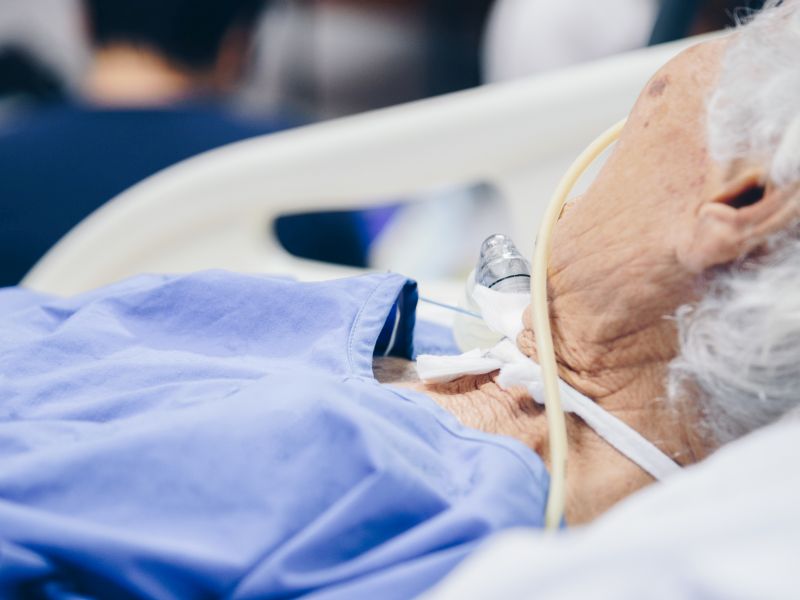Get Healthy!

- Posted April 2, 2020
With 3D Printer, N.Y. Hospital Converts Sleep Apnea Machines Into Ventilators
As COVID-19 pushes American hospitals to the breaking point, intensive care units are finding creative ways to deal with a looming shortage of lifesaving mechanical ventilators.
New York-Presbyterian Hospital last week began splitting single-use ventilators into machines that can serve two patients at a time. Now another New York-based hospital system, Northwell Health, has stepped up with another jury-rigged remedy: using 3D printing and HEPA filter add-ons to turn unused bi-level positive airway pressure (BiPAP) machines into the much-needed ventilators.
A BiPAP "is a noninvasive machine often used to help those with lung disease, COPD and severe sleep apnea patients," said team leader Dr. Hugh Cassiere, medical director for respiratory therapy services at North Shore University Hospital in Manhasset, N.Y.
Unlike a ventilator, a BiPAP doesn't breathe for you. Instead, it pushes pressure into the airway. And in this context, Cassiere said, that's a problem, because unlike full-support ventilators, "BiPAP machines only give you partial support."
The remedy: Add a small T-shaped adapter to a Philips Respironics V60 BiPAP machine; tweak its settings to provide full breathing assistance, and outfit both ends of the BiPAP's oxygen hose with high-efficiency particulate air (HEPA) filters to limit viral contamination.
Northwell's newly adapted BiPAP has already been tested on a dozen patients, some with COVID-19 and some without. Cassiere said the results demonstrate that the converted BiPAP "can be used to supply full ventilator support."
And New York Gov. Andrew Cuomo said in a media briefing today, "We are converting the BiPAP machines. This has not been done before, but Northwell, which is one of our premiere health care systems, has developed a protocol, and teaching and other hospitals now know how to do it. We just bought 3,000 BiPAP machines and 750 came in yesterday."
American Heart Association spokesman Dr. John Osborne, a practicing cardiologist in Fort Worth, Texas, reacted to the strategy. "This could really turn out to be a great, great thing," he said.
"Ventilators are enormously important," Osborne said. "It's life support. They're incredibly invasive. And being attached to a ventilator basically goes against all your body's natural instincts. But it's for a situation in which you can't breathe on your own at all, because you're knocked out or because your lungs are so full of pus, fluids and all that stuff that you need a machine to essentially breathe for you."
The big difference between ventilators and BiPAPs, Osborne said, is that ventilators are designed to be autonomous. "Once it's attached, you put in the numbers and the machine does everything for you," he said.
While a regular BiPAP keeps airways open as you inhale and exhale, Osborne said the patient has to initiate the breath to make it work. "And for a lot of COVID-19 patients that's just not possible," he added.
"So this is very inspiring," he said. "Because the more tools we have available at our disposal to address this pandemic, the better."
Cassiere collaborated with two Northwell colleagues on the BiPAP conversion -- Stanley John, respiratory therapy director, and Todd Goldstein, director of 3D design and innovation.
The team said its T-shaped adapter can be quickly reproduced using 3D printer technology. Northwell itself can print up to 200 adapters in a single day. Cassiere's team added HEPA filters to the tubing to reduce contamination.
Northwell's 23 New York metro-area hospitals are converting BiPAPs in anticipation of the looming ventilator shortage. Right now, the system still has some on hand.
Northwell says it has 350 BiPAPs available, and Cassiere noted that "the conversion, with the proper adapters and settings, only takes minutes."
Northwell plans to post details of its BiPAP conversion method online, along with the 3D printing design for the critical T-adapter.
More information
Learn more about how ventilators work at the U.S. National Heart, Lung, and Blood Institute.
SOURCES: Hugh Cassiere, M.D., medical director, respiratory therapy services, North Shore University Hospital, Manhasset, N.Y.; John Osborne, M.D., Ph.D., spokesman, American Heart Association, and CEO, State of the Heart Cardiology, Fort Worth, Texas; Northwell Health, press release, March 31, 2020
